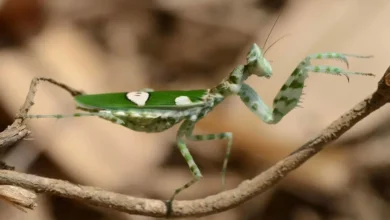Stagmatoptera femoralis is another species of praying mantis that stands out for its beauty and uniqueness. Although less known than its close relative, Stagmatoptera biocellata , this mantis shares many fascinating characteristics.
Key Features:
- Size: Similar in size to S. biocellata , females are typically larger than males.
- Coloration: They come in a wide variety of colors, from vibrant greens to browns and more muted shades. They often have intricate patterns that help them blend into their surroundings.
- Habitat: They are found mainly in the rainforests of South America, where they inhabit the vegetation.
- Diet: Like other mantises, they are carnivorous and feed on a variety of insects, spiders and small vertebrates.
Comparison with Stagmatoptera biocellata:
| Feature | Stagmatoptera femoralis | Stagmatoptera biocellata |
|---|---|---|
| Coloration | Greater variety of colors, more complex patterns | Bright green with fake eyes |
| Distribution | South America | South America |
| Size | Similar | Similar |
| Habitat | Rainforests | Rainforests |
Captive Care:
Stagmatoptera femoralis care is very similar to S. biocellata . They require a vertical terrarium with good ventilation, warm temperatures and high humidity. A varied diet of live insects is essential for their health.

Why choose Stagmatoptera femoralis?
- Varied beauty: The wide range of colors and patterns makes each individual unique.
- Scientific interest: Their behavior and adaptations are the subject of study for entomologists.
- Breeder Challenge: It can be a little more challenging to breed this species compared to other more common mantises.
Additional Considerations:
- Sexual dimorphism: Females are usually larger and more robust than males.
- Mimicry: Like other mantises, they use camouflage to hunt and avoid prey.
- Life cycle: Its life cycle includes several moults until reaching adulthood.



